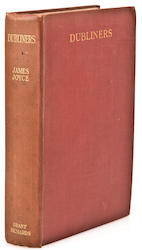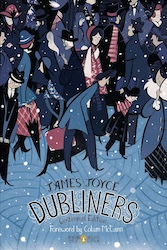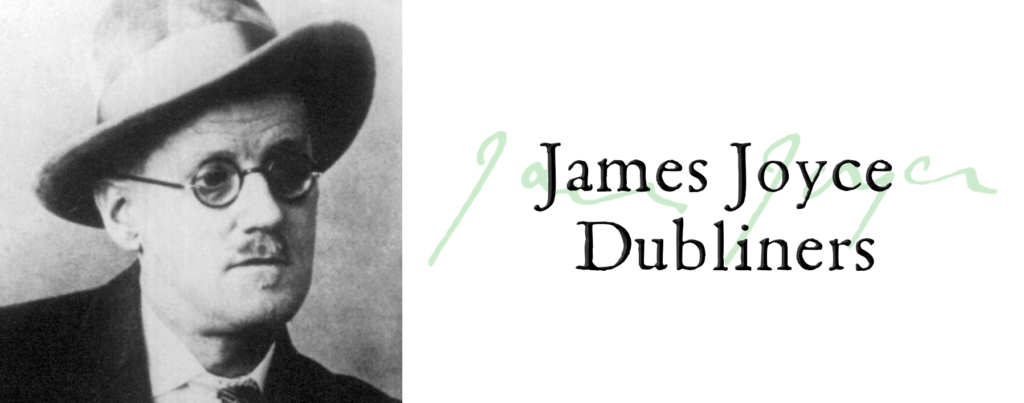Joyce Works: “Dubliners”
- At May 01, 2022
- By Great Quail
- In Joyce
 0
0
“My intention was to write a chapter of the moral history of my country and I chose Dublin for the scene because that city seemed to be the centre of paralysis. I have tried to present it to the indifferent public under its four aspects: childhood, adolescence, maturity, and public life. The stories are arranged in this order. I have written in for the most part in a style of scrupulous meanness….”
—James Joyce on “Dubliners”
Dubliners

Dubliners
By James Joyce
First Edition: Grant Richards, 1914

Dubliners
By James Joyce
Centennial Edition, Penguin, 2014
A collection of short stories published in 1914, Dubliners revolves around the everyday lives of men, women, and children in the Irish capital of Dublin during the turn of the century. Generally unhappy tales, they form a chronicle of lost innocence, eroding faith, missed opportunities, subtle hypocrisies, devastating ironies, and paralysis—always moral and intellectual paralysis.
Frequently listed among the best short stories of the twentieth century, the stories of Dubliners are told in a pared-down language using a minimal palette of words, images, and emotions; what Joyce described as “a style of scrupulous meanness.” Although the narrative represents Joyce at his most accessible, the stories contain little in the way of traditional plot structure, and certainly no climax or resolution of a typical sort—aspects which baffled many of his contemporaries. (And occasionally disappoints modern newcomers as well!)
Joyce balances these stories on the thematic fulcrum of the “epiphany,” an idea he developed when he was writing Stephen Hero, a rough draft of A Portrait of the Artist as a Young Man. As described by Joyce, an epiphany is “a sudden spiritual manifestation, whether in the vulgarity of speech or gesture, or in a memorable phrase of the mind itself,” and they “are the most delicate and evanescent of moments.” Each of these stories concludes upon an epiphany, a moment when its themes find sudden convergence; and through a character’s thoughts, words, or actions, the reader is gripped by a quiet moment of realization—a second where one lucidly glimpses a facet of the human heart, for good or ill.
To an attentive reader, these epiphanies trigger an almost delirious shift in consciousness as the mind undergoes a subtle rearrangement in perspective. The effect is something like walking slowly away from an impressionist painting, the muted brushstrokes and blurred colors coming together to reveal a complete picture. Vanity, shame, self-loathing, heartbreak, and regret are the main emotional portraits brought into such focus; but also fragile moments of beauty, quiet joy, resolution, and bittersweet nostalgia. It’s impossible not to see aspects of yourself in these characters, each story an oblique mirror reflecting the soul’s most private corners. As Joyce wrote, “Dubliners is about how we are everywhere—it’s the experience of modern urban life.”
Although each story can stand alone, taken as a whole, they form a powerful mosaic crafted from tiles of disillusionment, and their sequence has been carefully planned. Of all the stories, the final one gets the most attention. Concerning a frustrated writer named Gabriel Conroy, “The Dead” takes place during a single evening, a wintry night when Gabriel discovers that a dead lover haunts his wife’s past. Concluding with one of the most famous passages in English literature, “The Dead” is often anthologized, assigned, or read as a separate work. While it remains powerful even divorced from its companions, its impact is intensified when absorbed as the conclusion to the collection. Indeed, in many ways, “The Dead” acts as Dubliners’ crowning epiphany.
Advice for the First-Time Reader
Before reading Dubliners for the first time, an engaged reader may wish to brush up on Irish politics during the late Victorian period. Joyce makes many references to the events outside his characters’ lives, particularly Anglo-Irish politics, religion, and music, and a little understanding of these subjects can be rewarding. Of particular importance is the figure of Charles Stewart Parnell, an Irish MP who devoted himself to land reform, working at odds with the British until his adulterous fall from grace. The “betrayal of Parnell” is a theme that appears throughout Joyce’s work, and offers a key to understanding his characters’ motivating psychology. Many of Joyce’s characters are partly defined by their reactions to Parnell, ironically or otherwise, and the narrative invests Parnell with the aura of a fallen hero. (This comes to a peak in Finnegans Wake, where Parnell is literally transformed into a mythic figure.)
There are numerous “annotated” versions of Dubliners, but these should be saved for later readings. This isn’t like Ulysses—Dubliners demands quiet immersion. Interrupting your first reading with frequent trips to a guidebook disrupts the delicate mood of the stories, and ruins the subtle effect Joyce worked hard to create. Understanding all the contemporary references can wait for a second read-through.
Brazen Head Resources
Dubliners Criticism — A list of annotations, guides, and criticism published about Dubliners.
Joyce Works:
[Main Page | Dubliners | A Portrait of the Artist as a Young Man | Ulysses | Finnegans Wake | Poetry | Exiles | Other Works]
Author: Allen B. Ruch
Last Modified: 12 June 2024
Main Joyce Page: The Brazen Head
Contact: quail(at)shipwrecklibrary(dot)com

